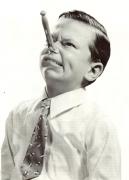I started this in follow-up to this post by GJM, but I reconsidered and am posting it as a new thread...
Interesting reading, highly recommended.Originally Posted by GJM
Question to 1911 gunslingers: My recollection is that the strong-hand thumb should be supporting the safety in the engaged position as the gun is holstered, making it unavailable to ride the hammer during the operation. Is that (supporting the engaged safety with the thumb) the accepted best practice?
I decided to do a little analysis work using the well-presented Front Sight data. In the list below, "preventable" means that in my personal opinion the incident would not have occurred if the shooter had been thumb-riding the hammer into the holster, assuming the use of an external-hammer gun. Cause summary is in parentheses after each item:
(1) preventable; failure to decock should have been immediately obvious by feel when holstering
(failure to decock; premature trigger finger)
(2) bad equipment (holster dangerous with that specific gun); holster interference + failure to properly engage safety
(failure to engage 1911 safety; equipment failure)
(LESSON: a last-minute changeover to a new equipment you haven't carefully tested in dry-fire is a Very Bad Idea)
(3) obsolete, unsafe practices: high-risk support hand positioning during draw
(4) theoretically preventable, but probably not in this case, if shooter strongly conditioned to put thumb on hammer before any motion into holster
(premature trigger finger; finger on trigger when holstering)
(LESSON: if you start to draw, complete your draw even if you realize you're premature, then safely reholster.)
(5) preventable; failure to decock should have been immediately obvious by feel when holstering
(failure to decock; premature trigger finger)
(6) preventable; failure to decock should have been immediately obvious by feel when holstering
(failure to decock; premature trigger finger)
(7) double (triple?) fail on 1911 controls during holstering -- disengaged safety, finger on trigger... grip safety depressed as the third fail?
(1911 controls failure; finger on trigger when holstering)
(8) double (triple?) fail on 1911 controls during holstering -- disengaged safety, finger on trigger... grip safety depressed as the third fail?
(1911 controls failure; finger on trigger when holstering)
(9) bad equipment (SERPA) inducing trigger pull during draw
(premature trigger finger with SERPA-type holster)
(10) bad equipment (SERPA) inducing trigger pull during draw
(premature trigger finger with SERPA-type holster)
(11) bad equipment (SERPA) inducing trigger pull during draw + premature 1911 safety disengagement
(premature trigger finger with SERPA-type holster; 1911 controls failure)
(12) shooter fail: bad day --> massive safety violation fail --> GSW
(13) bad equipment (SERPA-like Fobus) inducing trigger pull during draw
(premature trigger finger with SERPA-type holster)
(14) shooter fail: trigger pull during draw
(premature trigger finger)
(15) shooter fail: unsafe malfunction clearance with trigger held down; unsafe direction
(16) shooter fail: trigger pull during draw
(premature trigger finger)
(17) double (triple?) fail on 1911 controls during holstering -- disengaged safety, finger on trigger... grip safety depressed as the third fail?
(1911 controls failure; finger on trigger when holstering)
(18) preventable; even with finger on trigger during holstering, riding the hammer (or hypothetical Gadget) would have prevented ND
(finger on trigger when holstering)
(19) double (triple?) fail on 1911 controls during holstering -- disengaged safety, finger on trigger... grip safety depressed as the third fail?
(1911 controls failure; finger on trigger when holstering)
Here's the tally I came up with. This will add up to >19 due to compound failures counting in several categories:
6 NDs while holstering with finger on trigger:
4 preventable by ensuring 1911 thumb safety is engaged while holstering
2 preventable by riding hammer/Gadget while holstering (1 definite, 1 possible)
10 premature finger-on-trigger incidents:
4 ND on draw with SERPA/FOBUS assisted trigger discipline failures, of which one incident was preventable with proper 1911 safety
3 ND on draw after failure to decock: training scars from assuming trigger is always in heavy DA mode during draw
2 ND on draw due to shooter trigger discipline failure
1 "compound" ND due to incomplete half-draw -> premature finger on trigger -> hasty reholster -> bang
1 ND while pushing gun into dangerously incompatible Kydex holster with 1911 safety disengaged
1 frustration-induced self-inflicted GSW with gun pointed in unsafe direction
1 frighteningly incompetent execution of malfunction clearance drill resulting in ND
1 instance of outdated, unsafe training leading to support-hand GSW, which maybe could have been prevented by staff
Possible lessons to take from this, in no particular order:
* Prematurely engaging the trigger finger on the draw is a primary cause of NDs
* Holstering with your finger on the trigger (or clothing wadded up in your holster) leads to directly loud noises and burning sensations
* Riding the hammer/Gadget/1911-thumb-safety can prevent said loud noises and burning sensations
* SERPAs and SERPA-like holsters are substantially increase risk of ND during draw
* Managing the 1911 safety consistently and properly is life-or-death critical
* Hammer-fired TDA/LEM guns are safer to holster than striker-fired guns if you consistently ride the hammer as you holster
* Missteps may be embarrassing (getting startled into drawing prematurely) but hasty reactions after the misstep could be fatal
* There is no margin for frustration when you have a gun in your hand; if you get frustrated, call an instructor, make safe at half-speed and take a break
As a final note, I was surprised at how few of these incidents would have been prevented by riding hammer/Gadget while holstering. In the Front Sight environment, it appears that drawing your gun is significantly more likely to result in an ND than holstering. Also, an unskilled 1911 operator with a SERPA holster appears to be one of the most dangerous combinations in the pistol world.
Corollary: If you carry AIWB, you have basically no margin for error in trigger discipline while drawing. If you can't maintain basically perfect trigger discipline on your draw (index finger hard-indexed along gun, away from trigger until it's aligned with target) IMHO you have no business carrying AIWB. But I think everyone here knew that already, no?




 Reply With Quote
Reply With Quote





